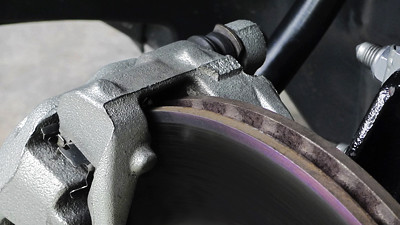Before bed-in
New brake pads and skimmed rotor were installed in place.

In order for the new brake set to work at its best, the rotors and pads should be properly bedded-in. This process can also be called as "brake conditioning", or whatever terminology.
Proper bedding improves pedal feel [no "on-off" braking feel], reduces or eliminates brake squeal, prevents and cures brake judder, reduces brake dust, and extends the life of pads and rotors.
If you Google around, you will find different procedures for brake bed-in. You may follow any of those procedures but I've got my own way of doing it. You don't have to follow my way but you can take a peep... :)
myProcedure for Bed-in
Bed-in procedure can be annoying to other drivers so I had to perform the bed-in around 4:00am to 5:30am in two sessions during which time there is virtually no other vehicle on the road.
1st Session
Drove and accelerated the car to approximately 80kph and then applied the brake lightly until the speed dropped to around 20kph in 100m. Then accelerated back to 80kph and maintained the speed for 1 minute and then applied the brake lightly again. Repeated 10 times without completely stopping the car. After 10th braking, drove the car slowly for another 5km to cool down the pads and rotor before stopping.
Stopped the car for 30minutes to almost completely cool the brakes.
2nd Session
Repeated Session 1 at 110kph
Here is the result after the 2nd session...

... there is a slight blue tint on the rotor [disc] surface which is not in contact with the pad and a light grey film on the surface which is in direct contact with the pad.

The blue tint tells the rotor has reached break-in temperature and the grey 'coating' is the by product of the chemical reaction between pad material and the rotor under extreme temperature and pressure. This layer enhances adherent friction hence minimizes squealing, increases braking torque, and maximizes pad and rotor life. Without which the braking force depends solely on abrasive friction.
3rd Session
For the 3rd Session, the car was driven 122km non-stop. During the first 50km the car was driven and braked normally in order to "bake-up" brake pads and rotors gradually and maintained the temperature and then performed THREE hard braking from around 120-140kph down to 20kph .
Fully baked rotor with near perfect transfer-layer* formation...
 *click HERE to find out what transfer-layer is all about and its significance.
*click HERE to find out what transfer-layer is all about and its significance.
 *click HERE to find out what transfer-layer is all about and its significance.
*click HERE to find out what transfer-layer is all about and its significance.
4th Session
This was the final session. The car was driven for 382km at 'normal speeds'. Four times hard braking to dead stop was performed during the trip at approx. 50km interval. Braking performance was excellent. The best ever! Silky smooth but sure and firm. Adherent friction is superb.
Rotor condition after brake bed-in [conditioning] process was completed...

3 comments:
I'm sorry if this is an ignorant question, but what happens if you only do part of the bedding in procedure? Maybe this is lazy, but doing a 100km and 300km trip is a pretty big commitment and given that I work full time and there's no way I could convince my wife not to drive the car for a week so I can do it over 2 weekends. If I just did steps 1 and 2 or 1,2 and 3, would I still receive some of the benefit or would I just be wasting my time?
BTW, thank you for taking the time to post all of your blogs. I think it takes a special type of person to take the time to help others. Hears to you.
Cheers.
I'm sorry if this is an ignorant question, but what happens if you only do part of the bedding in procedure? Maybe this is lazy, but doing a 100km and 300km trip is a pretty big commitment and given that I work full time and there's no way I could convince my wife not to drive the car for a week so I can do it over 2 weekends. If I just did steps 1 and 2 or 1,2 and 3, would I still receive some of the benefit or would I just be wasting my time?
BTW, thank you for taking the time to post all of your blogs. I think it takes a special type of person to take the time to help others. Hears to you.
Cheers.
It's OK as long as you don't apply emergency braking often during the first 300km.
Have a nice day Luke!
Post a Comment